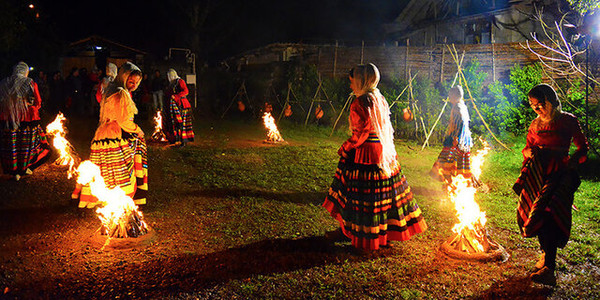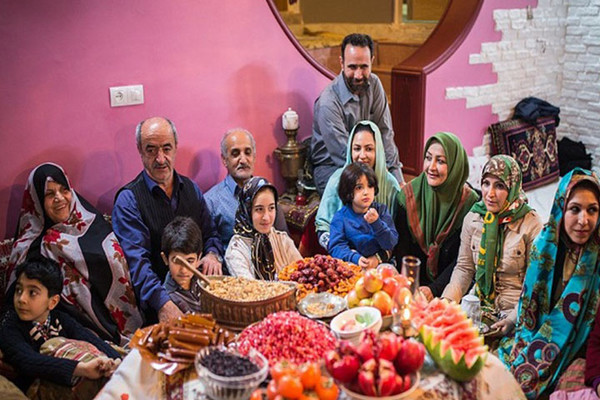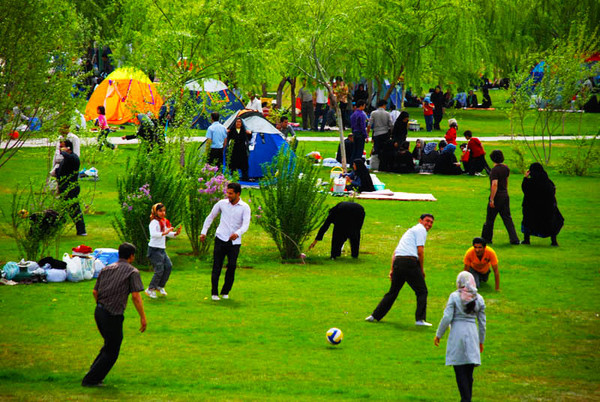
Nowruz, literary “ New Day” is a traditional Iranian new year celebration making the arrival of spring time and the first day of the year in Iran, dating back to at least the 6th century BCE, marking the victory of spring over darkness. Iran’s oldest records of Nowruz go back to the Arsacid/ Parthian times. (247 BC-224 AD).
Nowruz is a celebration that marks the end of an old year and the beginning of a new one and is celebrated on the day of the astronomical vernal equinox, which usually takes place on March 21.
It has been celebrated in Iran for over three thousand years by all the people regardless of ethnicity, religion, or language. Its roots are as a feast day in Zoroastrianism, a religion practiced in ancient Persia that viewed the arrival of spring as victory over darkness.
There are moments in human life that embodies lasting spiritual and cultural dimensions and at the same time are dear to hundreds of millions of people around the world. With several thousand years of history, civilization and culture, Nowruz is one of these moments in the collective memory of generations and communities. Moreover, Nowruz is not only a strong bridge between the past, present and future, but also a symbol of the protection of common values and ideals while respecting cultural diversity. Transmitted from one generation to the next, Nowruz represents a sense of continuity and transition while strengthening feelings of belonging to shared memories and traditions. As such, Nowruz is not merely a moment, a celebration or a simple event; it is a thriving example of living heritage.
Nowruz connects the hearts of the people, serving as the common language for a multitude of populations spanning different countries and ethnicities. At its heart, Nowruz promotes the true human values of peace, solidarity, empathy and friendship.
More than 300 million people celebrate the Persian New Year, which has been observed for more than 3,000 years in different regions, including Iran, the Balkans, the Black Sea Basin, the Caucasus, Central Asia, the Middle East and others.
The celebration is part of UNESCO’s Representative List of the Intangible Cultural Heritage of Humanity, and the United Nations General Assembly of 2010 proclaimed March 21 as International Nowruz Day.

What happens during Nowruz?
Celebrated in Iran for more than 3,000 years, Nowruz is an ancestral festivity marking the first day of spring and the renewal of nature. Meaning “New Day” in the Persian language, it is a message of rebirth and a symbol of new beginnings, opportunities and hopes. In Iran, Nowruz includes rituals, ceremonies and cultural events. One of the significant symbols of Nowruz is a special table known as “Haft-Sin”. It is decorated with meaningful components, each symbolizing lovely notions such as the rebirth of nature, fertility, health, beauty, wealth, purity and prosperity. As one of its traditions, Nowruz brings Iranians together as they pay visits to the elderly and other members of the family.
Nowruz is preceded by “Chaharshanbe Suri”, or the fire festival, on the eve of the last Wednesday to bid farewell to the old year and start a prelude to the new year and last for 13 days, and it’s an opportunity to reflect on the past and set intentions for the future. Iranians celebrate the fire festival by jumping over bonfires and using firecrackers. Afterwards people gather in their elders’ houses and enjoy” Ajil”, a mixture of nuts, raisins, figs, etc.
Families gather around, waiting for the exact time of the New Year (Saal Tahvil) and the official first day of spring. Shortly after Saal Tahvil, the ritual known as Eid Didani starts and like Republic of Korea during Seollal holidays, people pay visit to elders, family and friends. Nowruz festivities begin right after “Saal Tahvil” and last for thirteen days.
Nowruz is celebrated by Haft Sin: Households decorate a table with seven items that represent the new season which begin with the Persian letter sin (S). The items include:
Sabzeh (wheat, barley or lentil sprouts growing in a dish): represents rebirth.
Sib (apple): represents beauty, earth.
Samanu (sweet pudding made from wheat germ): represents fertility.
Sumac (sumac fruit): represents the color of sunrise.
Senjed (dried oleaster): represents Love.
Serkeh (vinegar): represents patience.
Sir (garlic): represents good health.

The following items may also appear on the Haft Sin table as ornaments or for the sake of completeness. Holly Quran, Divan-e Hafez(poetry book), a mirror, coins(as a symbol of wealth), painted eggs, candle sticks, a bowl of water and a live goldfish, hyacinth, flowers, special sweets, nuts and so on…
”Sizdah Bedar “, Nature’s Day, often referred to “Thirteen Outdoors”, is an enchanting festival celebrated annually on the thirteen day of Nowruz (Farvardin- the inaugural month of the Iranian Calendar. “Sizdah “ means thirteen, and “ Bedar” means to get rid of , i.e “ “getting rid of thirteen”. It has been possibly considered as a tradition because some people believe the thirteen is an unlucky number, and everybody should get rid of it.
This day beckons families and friends to step outside, lay down their picnic spreads, and bask in nature’s bounty.
Sabzeh, the greenery grown for the Haft- Sin setting is thrown away into running water.
In another word, Nowruz is also the natural rebirth of nature and despite its Persian characteristics can easily be celebrated by all the people in the world.
In a world faced with unprecedented global challenges, such as pandemic, unilateralism, extremism, violence, hostility and conflict, let us all be inspired by Nowruz and its promise of peace, harmony, solidarity and prosperity.

Iran and South Korea relations
It has been more than 60 years since Iran and South Korea started diplomatic relations on Oct, 1962. Iran and South Korea’s long running relationship started with cultural exchanges date back to more than 1000 years ago, mentioned in “Kushnameh” an ancient Persian epic poem and love story, that can estimate exchanges between Silla and Persia of the Sassanian dynasty in the 7th century.
As mentioned in Kushnameh, the relationship between two countries is deeply rooted in history. In addition, Iran and Korea are very deeply related not only in culture, history and economic exchanges, but also emotionally, resemble each other. Both countries share cultures that value family and respect elders.
The countries’ friendship is symbolized in a series of namesakes: Tehran Street in Seoul and Seoul Street in Tehran, capital of Iran are prominent symbols of the special bond that has withstood the test of time and pave the way for a brighter future.
The two countries have maintained good and close relations since the established diplomatic ties in 1962, Iran was the only oil producing country that supplied oil to South Korea during the 1973 oil shock.
Iran and South Korea enjoy much close economic ties with bilateral trade totaling $18 billion in 2008. From 2015 to 2018, South Korea was Iran’s third largest import partner. If the diplomatic situation between the two countries is eased, a huge amount of political, cultural and economic exchanges, expected to take place.
Happy Nowruz!


